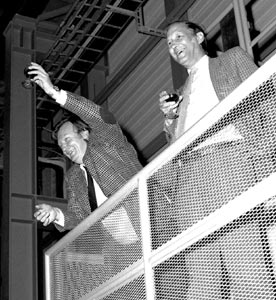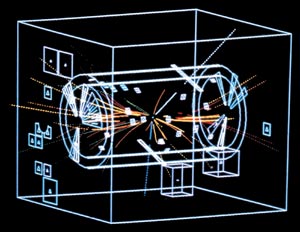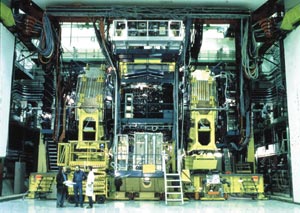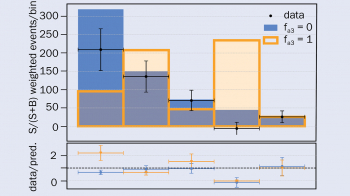Pierre Darriulat, who was spokesperson for the UA2 collaboration between 1978 and 1985, looks back at the events surrounding the discovery of the W and Z particles at CERN in 1983.

The decade between 1967 and 1976 witnessed an impressive sequence of experimental and theoretical discoveries that changed the vision we had of the world – from the prediction of electroweak unification in the lepton sector (1967-1980) and the discovery of deep-inelastic electron scattering (1969), to asymptotic freedom and quantum chromodynamics (1973) and the discoveries of the J/Ψ (1974) and naked charm (1976). By 1976 the Standard Model of particle physics was in place, ready to confront experiments, and it was clear that a new accelerator was required to explore the electroweak unification sector. This is where the weak gauge bosons, W and Z, were expected, with approximate masses of 65 and 80 GeV/c2, respectively. The arguments for the future LEP machine were already strong.
I remember being asked by John Adams (then executive director-general of CERN) to convene the Large Electron Positron Collider (LEP) study group in April 1976, and to edit the report. In practice this meant learning from theorists John Ellis and Mary K Gaillard all the beautiful new physics that was waiting for us, putting together some documents on the feasibility of the machine (which were available following Burt Richter’s seminal paper), and wrapping it all up as quickly as possible together with some bread-and-butter experimental comments. It took only seven months to get it all done to the satisfaction of Adams, who wanted to push the LEP project in the wake of the success of the Super Proton Synchrotron (SPS), which was about to start operation.
The proton-antiproton choice
The situation in 1976 sets the context in which the proton-antiproton decision was made. The pressure to discover the W and Z was so strong that the long design, development and construction time of the LEP project left most of us, even the most patient, dissatisfied. A quick (but hopefully not dirty) look at the new bosons would have been highly welcome. But when proton-proton colliders such as the Superconducting Intersecting Storage Rings (SCISR) were proposed in this spirit, they were “killed in the egg” by the management at CERN, with the argument that they would delay – or even worse, endanger – the LEP project. This was accepted as a serious argument even by the proponents of such colliders.

The same argument did not apply to the proton-antiproton collider as it did not require the construction of a new collider ring and could be proposed as an experiment. One might object that this sounds like a bad joke, because it implied the construction of an antiproton source, and that turned out later to include a collector/accumulator accelerator complex (AC/AA).
However, it remains true that the existence of the SPS, which was soon shown to perform extremely well, was obviously an essential element of the success of the proton-antiproton project, for which John Adams has to be credited. It is also true that he found it hard to swallow that his newborn baby should be tinkered with at such a young age and turned into a collider that had only a small chance of working. This was indeed the feeling of the vast majority of machine experts at the time, and much of Carlo Rubbia’s merit is that he pushed his ideas for the proton-antiproton collider with an untiring determination in such an adverse climate. Indeed, he pushed not only with determination but also with a clear vision of what his proposals would lead to, and with a deep understanding of the machine-physics issues at stake.
A threat from Fermilab
Another argument also made it possible for the proton-antiproton project to break the LEP taboo. If CERN did not buy Carlo’s idea, it was most likely that he would sell it to Fermilab. This threat was clear and had a great deal of weight when the decision was made at CERN. Despite the fact that the Fermilab machine was not performing well enough at the time to be used as a proton-antiproton collider, the threat very effectively accelerated the well known sequence of events that followed the publication in 1976 of the paper by Carlo Rubbia, Peter McIntyre and David Cline. In 1977, after the proposal had been made to CERN and Fermilab to produce the W and Z with existing machines, a feasibility study was undertaken by Franco Bonaudi, Simon Van der Meer and Bernard Pope that led to the Antiproton Accumulator (AA) design. At the same time a detector study was initiated under Carlo that led to the UA1 design, and the Initial Cooling Experiment (ICE) was proposed to the SPS Committee. The success of ICE was demonstrated in June 1978 and the approval for the UA1 detector followed immediately. Only six months later UA2 was also approved.

I strongly believe that if it had not been for Carlo, there would have been no proton-antiproton collider physics in the world for a long time, maybe forever. Whether the weak bosons would have been discovered at LEP, at the Stanford Linear Collider (SLC), or at some other collider is another matter, but it would have taken another six years at least. One might argue that six years is not really that long, but the top quark would not have been discovered either (other than indirectly from radiative corrections at LEP), nor would we have learned from the vast and rich amount of strong and electroweak physics data that have been collected at the SPS and Tevatron colliders – not to mention the low-energy LEAR physics, antihydrogen, glueballs, CP violation, antiprotonic helium atoms, etc.
The influence of the CERN ISR
I would like to say a word here about the CERN ISR and the seminal role that they played in the success of the proton-antiproton project. The ISR were the world’s first hadron collider. This was the machine on which the young generation of machine physicists who designed, built and operated the antiproton source and the proton-antiproton collider (and later on, maybe to a lesser extent, LEP) gained their experience and their expertise. It worked superbly, exceeding its design goals in both energy and luminosity. It is the machine on which Van der Meer’s ideas on stochastic cooling were tried for the first time, where they were studied and understood. It is also the machine with which a generation of physicists learned how to design experiments at hadron colliders.
When the first ISR experiments were being designed the strong interaction was still a complete mystery; when the machine was finally shut down QCD was in place. I do not mean to say that it is ISR physics that has taught us about QCD, but it contributed to the development of several of its ideas. ISR physics has helped us greatly in drawing a clear picture of hadron collisions, without which we would not have been able to design so effectively the UA experiments at CERN, and CDF and D0 at Fermilab. We, in UA2, were particularly indebted to the ISR, where many of us had previously been working and for whom this experience was an essential asset in designing a good detector.
I would also like to recall the extraordinary concentration of outstanding talents that the proton-antiproton project succeeded in attracting. One reason was of course that between the SPS and LEP projects – one completed and the other as yet unborn – its timing was in some sense ideal. But the other reason, possibly more important, was the challenging nature of the project, which attracted extremely bright engineers and physicists, both machine physicists and particle physicists.

The challenge of designing, constructing and assembling the antiproton source and detectors, and of getting them to work in such a short time, was enormous; as was that of digging and equipping the large experimental halls required for housing the new detectors that had to be alternately rolled in and out between collider and fixed target periods; and that of transforming the SPS into a collider. The amount of ingenuity that went into all these achievements was truly outstanding.
My best memory of those times may indeed be the good fortune I had to work with so many talents, and, in the case of UA2, to enjoy collaborating with such bright colleagues, senior physicists, postdocs, students or physicists of the same generation as mine.
The UA1/UA2 competition
The competition between UA1 and UA2 was real and lively, but relatively unimportant; it was more a kind of game, and we had a lot of fun playing it. There was no doubt that Carlo was the king of the proton-antiproton kingdom and was recognized as such by all of us. Undoubtedly, he would have had to take the blame if the proton-antiproton project had been a failure, but as it turned out to be a success he deserved to take the fame.
Personally, I had been working in Carlo’s group for six years or so, mostly on K physics. I had joined him as a postdoc in the mid-1960s, coming from nuclear physics, and I had learned from him the basis of experimental particle physics. I had always been impressed by his brightness, by the readiness of his mind and by his far-reaching vision; and I respected him, as I do today, as someone of a clearly outstanding stature. To respect him as the king did not mean to belong to his court, however, and we in UA2 were particularly keen on finding occasions when we could proclaim that: “The king was naked.” Such occasions were very rare – the king was usually dressed splendidly – so they were all the more enjoyable.
The design of the UA2 detector was a success and its construction and running-in went extremely smoothly. We were rightly proud of it. For only one-third the cost of UA1 – a condition of our approval was that UA2’s cost should be significantly lower – we managed to build a detector that was ready on time, that saw the W and Z as soon as the collider luminosity made it possible (and at the same time as UA1 did), that measured the W and Z masses more accurately than UA1, and that was better than UA1 at detecting and measuring hadron jets. It was easier to design UA2 than UA1 because UA2 did not have to be a multi-purpose detector and could afford simply to ignore some of the physics, in particular to be blind to muons. While the main asset of the UA1 detector was its central detector, that of UA2 was its calorimetry.

One difficulty in the design process had been judging how well the machine would perform, how long it would take to get going, and how noisy and hostile an experimental environment had to be expected. Sam Ting’s detector (which was ultimately not approved) could have run in almost any background conditions, but could only see muons; the UA1 central detector required very clean conditions; UA2 was somewhere in between.
Expectations exceeded
The collider turned out to be an exceedingly clean machine and we had grossly underestimated how fast its luminosity would increase. In particular we had left an open wedge in our calorimeter, instrumented with a magnetic spectrometer, to do quietly (so we thought) some exploratory measurements while the machine was being tuned and run in. The wedge did not stay open very long, for the performance of the machine progressed at high speed, and we were able to tackle the first high-luminosity run with full calorimetric coverage.
I do not wish to repeat here the oft-told stories about the first seminars and the first publications reporting the UA1 and UA2 discoveries of the weak bosons, but I wish to comment on how we perceived these events. As I have already said, we were all expecting to see the weak bosons, we had no competition to fear from other laboratories and there was no question of UA2 “scooping” UA1 in the sense of stealing a Nobel prize or whatever. There was no doubt in our minds that Carlo and of course Simon deserved the whole credit for the success. The real outstanding achievement was the production of the weak bosons, not their detection. Without Carlo and Simon there would have been no proton-antiproton collider, but without UA1 and UA2 there would have been other experiments that would undoubtedly have done as good a job. The success of UA2 was largely due to the quality of the many physicists who had worked together very efficiently, with an excellent team spirit, and it was impossible to single out a few of them as deserving a larger part of the credit.
Of course there was competition; we enjoyed being faster or more clever than UA1 whenever we could afford to be, as when we were first at reporting to the 1982 Paris Conference the observation of very clear hadron jets, a breakthrough in the history of strong interaction physics. But this was not the dish, it was just the spices. The dish was serious business. It was reporting to the physics community what we had been finding. It was writing papers that would stay forever as important documents in the history of science.
In retrospect I am proud we resisted the pressure that was exerted on us to publish faster than we thought we had to. It would have been stupid and childish to give in, and would not have shown much respect for science. In fact this pressure made us almost overreact and, in the case of the Z, it caused a delay of nearly two months between the UA1 and UA2 publications because we preferred to wait for the imminent new run and collect more statistics before publishing. There was virtually no dissenting opinion in UA2 that we should have behaved differently – we all felt quite strongly about it. In particular the wiser and more experienced members of the collaboration (I mean the generation before mine) gave their full support to this line.
It is obvious today that there would have been no point in making a fuss about an event detected in 1982 that was most likely a Z, but one of its decay electrons was not identified because it hit a coil of our forward spectrometer magnets. We were wise to wait for more statistics before publishing the Z results. The issue at stake was not to bet on the truth, but to behave as if we were the only experiment.
Scientists of my generation are very fortunate to have witnessed such amazing progress in our understanding of nature, in phase with our own scientific life. It is remarkable that this has not only been the case in particle physics but also, and maybe to an even greater extent, in astronomy and life sciences. While many questions remain unanswered in each of these three fields, none can be put aside any longer as being a mystery inaccessible to science. Our vision of the world has changed dramatically. Having had an opportunity to contribute to this progress, however modest our contribution may have been, is very good fortune. May science be smiling on the next generation as kindly as it did on us, with the new physics that the LHC will soon reveal.
Further reading
www.nobel.se/physics/laureates/1984
Apart from the Nobel lectures of Rubbia and Van der Meer, the interested reader may consult a list of relevant references in John Krige, History of CERN, volume III, chapter 6 (Elsevier, Amsterdam, 1996).
•This article is based on a talk given at the symposium held at CERN in September 2003, “1973: neutral currents, 1983: W± and Z0 bosons. The anniversary of CERN’s discoveries and a look into the future.” The full proceedings will be published as volume 34 issue 1 of The European Physical Journal C. Hardback ISBN 3540207503.








